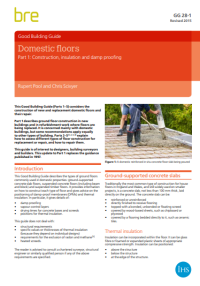Domestic floors: Part 1: Construction, insulation and damp proofing
BRE (Building Research Establishment) is an independent, research-based consultancy, testing and training organisation, operating in the built environment and associated industries.
Domestic floors: Part 1: Construction, insulation and damp proofing (GG28/1 revised 2015) was written by Rupert Pool and Chris Scivyer, and published by BRE on 30 March 2015. It is part 1 of a 5-part Good Building Guide that considers the construction of new and replacement domestic floors and their repair. It updates guidance published in 1997.
The 8-page part 1 describes ground floor construction in new buildings and in refurbishment work where floors are being replaced. It is concerned mainly with domestic buildings, but some recommendations will also apply to other types of building.
It describes the types of ground floors commonly used in domestic properties; ground-supported concrete slab floors, suspended concrete floors (including beam and block) and suspended timber floors. It provides information on how to construct each type of floor and gives advice on the positioning of damp-proof membranes (DPMs) and thermal insulation.
In particular, it gives details of; damp proofing, vapour-control layers, drying times for concrete bases and screeds, positions for thermal insulation. It does not deal with; structural requirements, specific values or thicknesses of thermal insulation, requirements for the exclusion of radon and methane or heated screeds.
The contents of part 1 are:
- Introduction.
- Ground-supported concrete slabs.
- Suspended concrete (beam and block or plank).
- Suspended timber.
- Screeds for concrete bases.
- Thermal insulation and membranes for concrete bases.
- Chipboard.
- Conclusion.
- References.
- Further reading.
Parts 2–5 explain how to assess different types of floor construction for replacement or repair, and how to repair them.
[edit] Find out more.
[edit] Related articles on Designing Buildings Wiki
- BRE articles on Designing Buildings Wiki.
- BRE Buzz articles on Designing Buildings Wiki.
- BRE Buzz.
- BREEAM.
- Building Research Establishment.
- Concrete slab.
- Damp proofing.
- Damp-proof membrane.
- Floor definition.
- Floor insulation.
- Flooring defects.
- Floors.
- Insulation for ground floors.
- Laminate flooring.
- Screed.
- Thermal insulation.
- Types of flooring.
- Vapour-control layer.
Featured articles and news
RTPI leader to become new CIOB Chief Executive Officer
Dr Victoria Hills MRTPI, FICE to take over after Caroline Gumble’s departure.
Social and affordable housing, a long term plan for delivery
The “Delivering a Decade of Renewal for Social and Affordable Housing” strategy sets out future path.
A change to adoptive architecture
Effects of global weather warming on architectural detailing, material choice and human interaction.
The proposed publicly owned and backed subsidiary of Homes England, to facilitate new homes.
How big is the problem and what can we do to mitigate the effects?
Overheating guidance and tools for building designers
A number of cool guides to help with the heat.
The UK's Modern Industrial Strategy: A 10 year plan
Previous consultation criticism, current key elements and general support with some persisting reservations.
Building Safety Regulator reforms
New roles, new staff and a new fast track service pave the way for a single construction regulator.
Architectural Technologist CPDs and Communications
CIAT CPD… and how you can do it!
Cooling centres and cool spaces
Managing extreme heat in cities by directing the public to places for heat stress relief and water sources.
Winter gardens: A brief history and warm variations
Extending the season with glass in different forms and terms.
Restoring Great Yarmouth's Winter Gardens
Transforming one of the least sustainable constructions imaginable.
Construction Skills Mission Board launch sector drive
Newly formed government and industry collaboration set strategy for recruiting an additional 100,000 construction workers a year.
New Architects Code comes into effect in September 2025
ARB Architects Code of Conduct and Practice available with ongoing consultation regarding guidance.
Welsh Skills Body (Medr) launches ambitious plan
The new skills body brings together funding and regulation of tertiary education and research for the devolved nation.
Paul Gandy FCIOB announced as next CIOB President
Former Tilbury Douglas CEO takes helm.
UK Infrastructure: A 10 Year Strategy. In brief with reactions
With the National Infrastructure and Service Transformation Authority (NISTA).
























